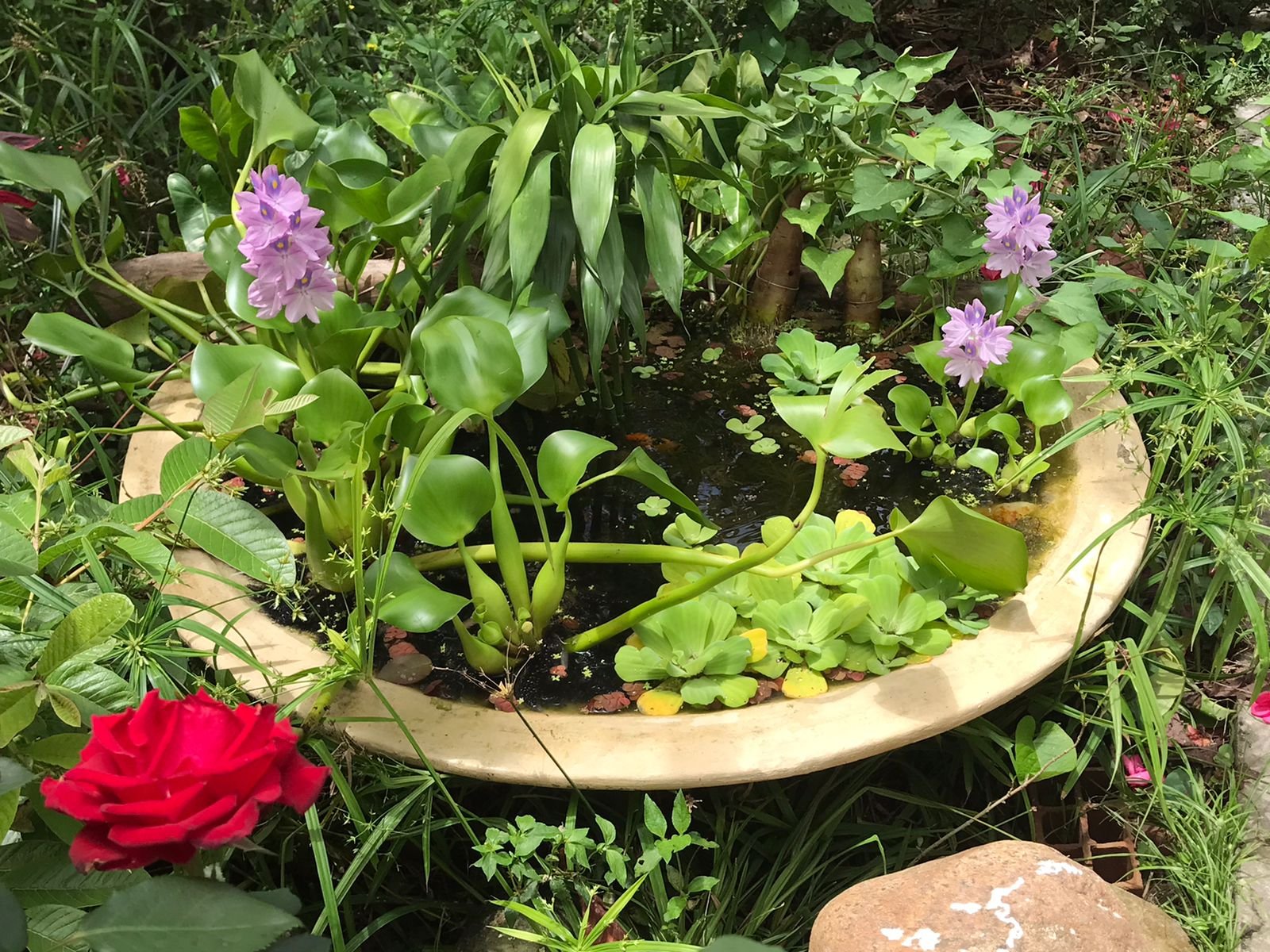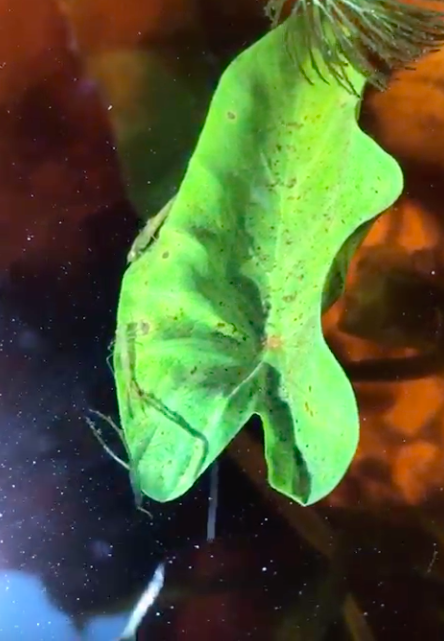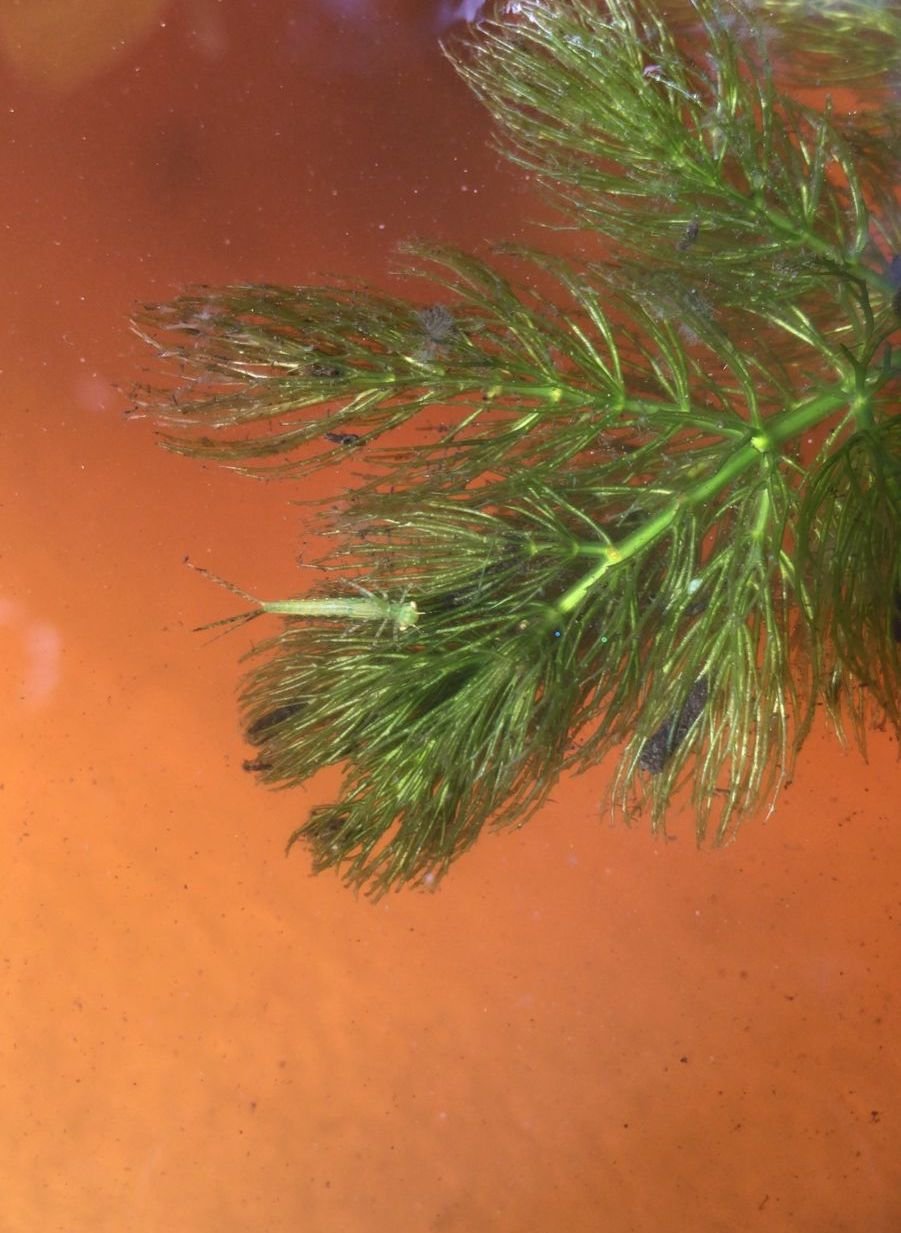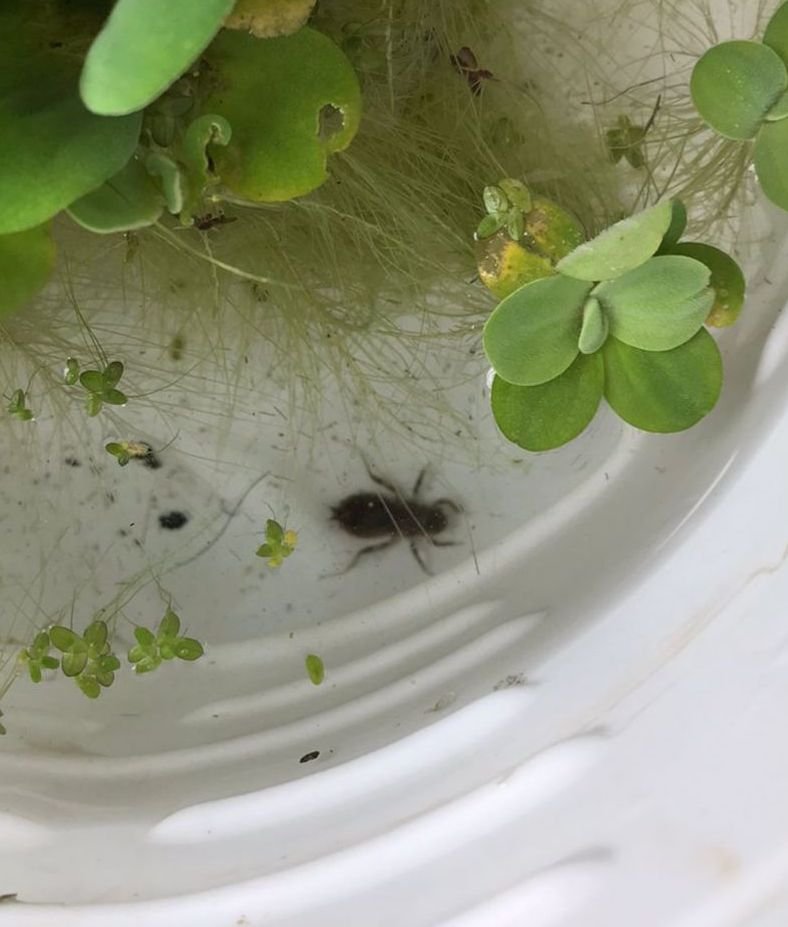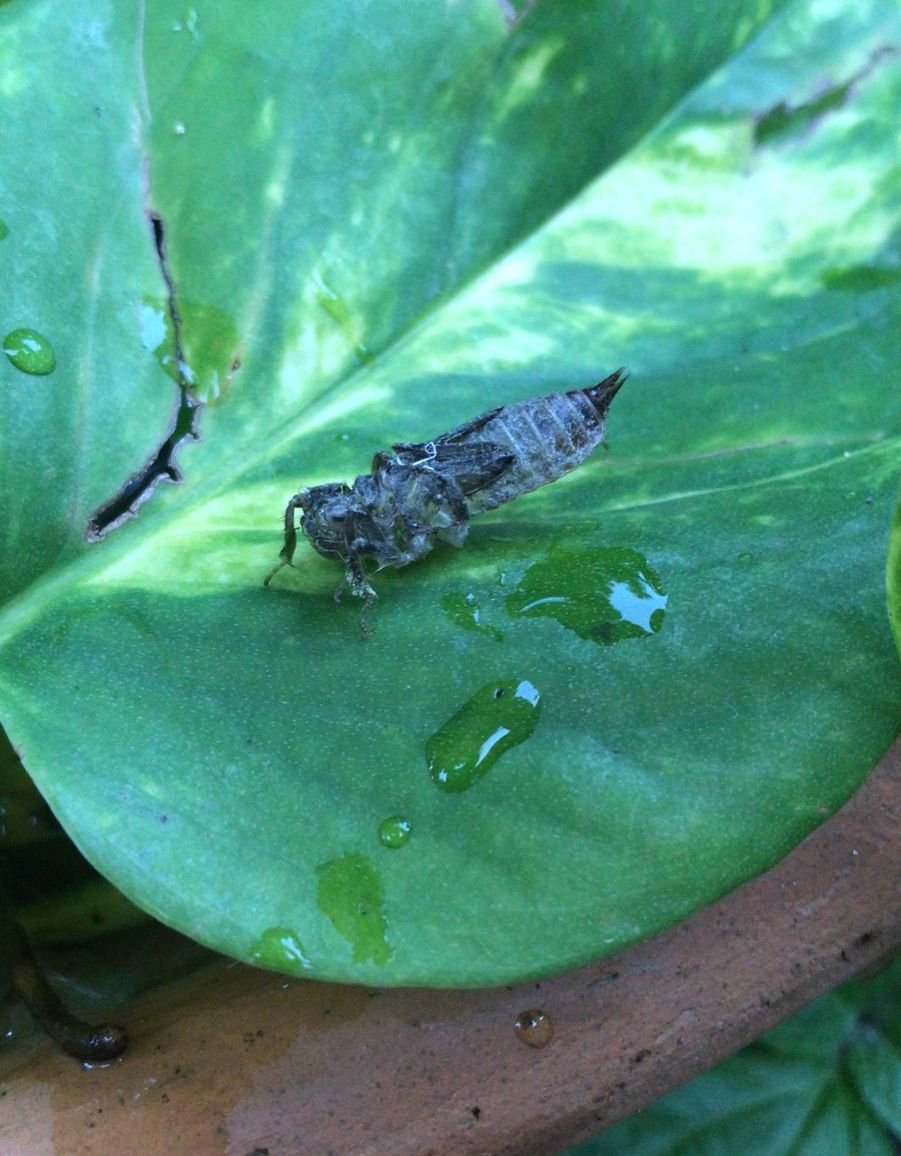All that Which Mini Ponds Can Teach
The average citizen knows very little about nature and their local ecosystems. It has become easier for us to imagine a mosquito that is genetically engineered to be sterile, than to learn about which animals in our area are their natural predators. This is probably because it is easier to vote for a politician who might endorse research and implement anti-dengue-fever policies, than to observe and study the behavior of local wild-life. Most of us don’t have the time and resources for this type of research, but, most importantly, we lack interest or motivation (who knows which came first). We don’t need to look closely, however, to see that government policies and politicians are flawed and misguided, specially with regard to environmentally sustainable practices. An alternative to continuing relying on them could be taking certain things into our own hands, even in the microcosm of our own lives.
Danny, surrounded by water lettuce and hyacinth, and a sweet potato.
Luckily, I spent the pandemic socially isolated in a house with a big garden in an area of Brazil known for rocky Atlantic forest vegetation, and was able to work remotely. Time and resources were available to me, and I took advantage of that to begin doing all those things we think about doing but never get around to. A vegetable garden, composting, bread making, sunbathing, exercising and so on. But the pond saga began later on, and it consumed me in an unexpected way.
Quickly, it became clear to me that building a mini pond is a difficult and valuable biology lesson. The more you learn, the more you realize how little you know.
It all began with a frog’s nightly visits to the dogs’ water bowl. After the first time I saw it, every evening around the same time, its appearance was certain. And every time I saw him or her, now called Danny (after Danny DeVito), I would think about how my neighbourhood is hostile to wildlife — streams are polluted, trees are cut down to make space for concrete structures, and spontaneous plant growth is considered “dirt”. After a couple of weeks, I had decided to make a mini pond for Danny, which took me down a rabbit hole. How can I make a pond without creating a mosquito proliferation hotspot? How can I do it without dragging an extension cord through the yard to turn on an electric filter? The questions have never stopped since then.
Let me tell you about some of what I’ve learned — which is far from all there is to know.
Before
After
Aquarium stores are creepy and sad. The fish are too cheap, treated as disposable, and the systems are delivered as controlled hygienic environments, where the human can have the most control possible over the variables. In nature, though, there are infinite variables to consider, which are all unpredictable and overwhelming.
Basically, several types of fish eat mosquito larvae, not all of these fish exist in nature. Many are domesticated breeds like dogs and cats. So, creating a goldfish biotope is an oxymoron. Nevertheless, they need a filtration system and most need water aeration. In nature, there aren’t pumps and filters doing this for the fish, but recreating this natural environment is incredibly difficult, and a powerful lesson about nature.
In short — fish poop in the water, bacteria break down this waste, turning it into nutrients. These nutrients are, in turn, consumed by aquatic plants and algae. The more plants are consuming these nutrients, fewer nutrients are left for the algae to feed on, keeping it under control and the water clear. Some aquatic plants, especially the ones that are fully submerged, oxygenate the water as well. This is the basic principle. The trick is finding a balance between these elements.
Becoming aware of these elements, which are intensely present in our daily lives, is enlightening. We notice water and air quality, how frequently it rains, how often and where the sun shines, and which living beings we share this space with. For instance, pebbles, rocks and rough surfaces underwater are good for hosting plenty of bacteria, but very small pebbles can be eaten by bigger fish and some rocks could release nutrients in the water that alter its pH. Drastic pH levels and changes stress the fish out (sometimes causing death), and it is possible to identify changes in their behavior.
The water out of our tap kills fish; It has too many chemicals. There is a whole process of waiting for the chemicals to evaporate, or treating the water in different ways. Even rain water can be contaminated by air pollution. As water evaporates from heat and sun, the pond water becomes harder, denser with nutrients, and the pH is altered with time. On the other hand, the aquatic plants need the sun, and you can see when they have had too much sun; the leaves become yellow.
Partial water changes every few weeks are great to keep it clear and clean, as soon as you make sure you are not discarding eggs, nymphs, and other little animals who have made a home out of the pond. And by partial I mean: never replacing more than 40% of the total water content at once, as to not disturb the ecosystem too much too quickly. Nutrient rich fish water can be used to water potted plants, and clean treated water can be used to fill the pond back up.
To become conscious of the balance between sun shine and rain as it relates to beings other than yourself is quite enriching. And, trust me, a lot of other beings will show up to a natural pond. Within the first month, I was seeing eggs and worms, I took pictures and tried to identify what they were. The fish ate the worms, and the eggs became snails. Snails eat all sorts of leftover organic matter and help clean the pond (much like shrimp), and some even oxygenate the water. But if they die, there is a foul smell, and they can reproduce out of control. Carp like to eat these small snails, with the softer shell. But smaller fish won’t. Leeches, however, will keep the snail population under control, sucking them dry and leaving only the shell. You can distinguish a leech from a worm by the way it moves and its shape — they have small heads and wider-round back-ends, moving like accordions (as opposed to wiggling around). If one latches on to your skin, don’t worry, most aren’t harmful to humans and fish. These leeches do show up out of nowhere, and can become even more rampant than the snails. In this case, you can use dried almond tree leaves to keep their population under control. Underwater, these leaves release nutrients that control the water quality.
The most exciting being I witnessed making a home out of the pond was a dragonfly. One day, I noticed one flying, dipping its tail on the surface of the water over and over. Apparently, it was laying its eggs. There was so much I didn’t know about the life cycle of a dragonfly, and I got to witness it closely. It turns out, dragonflies spend most of their lives underwater, as nymphs. Dragonfly nymphs will eat leeches, larvae, tadpoles and even small fish. They begin as tiny, transparent or green nymphs, with legs, head and tail. It eventually grows into a 6-legged, quick paced brown-roach-looking thing underwater. Eventually (in my case almost a year later) it sheds its skin like a snake and takes off flying, to mate and drop eggs in another pond (if they don’t get eaten by birds first, that is). Moreover, it’s an animal so ancient it coexisted with dinosaurs. Its ancestors were around more than 200 million years ago.
Sometimes, you try to solve one problem and create another. One of my fish died because of what appeared to be a fungal infection. There were white, cotton-like spots in the pond and on the fish. Although a small amount of pure sea salt in the water can help combat bacterial and fungal breakouts (even in fresh water ponds), this salt-treatment killed my aquatic plants. Several things can kill plants. Fish nibble on the roots, caterpillars and worms feed on the leaves, lack of sun, etc. Of course, I want the butterflies to do their thing; the trick is to have enough plants, so you can sacrifice one or two to them.
In fact, aquatic plants are not easy to find, and are often more expensive than fish. Transporting them long distances is tricky, and when you do find something, it’s usually the same type of (useful although invasive) species. There are various types. Some float; some root in only water with dry leaves; some root in substrate at the bottom of the pond or in submerged pots; some need to be completely submerged and are kept from floating up by rocks, pebbles, or substrate. Substrate is tricky because it can easily affect the water, its pH, its clarity, etc. So, you have to find a way to top nutrient-rich soil with sand and rocks, so it doesn’t make a mess. Variety is valuable because each plant has its characteristic and behavior, and can play differently important roles.
Sweet potato, for instance, is great at removing nitrates from the water. One third of it is submerged, and the rest above water. Quickly, roots grow down, and leafy vines up. But after 2 months it is best to remove, since, if they rot, the fish could die. At this point, you can detach stems and place them back in the water, discarding the rest in the compost. New roots will grow, and the process can be repeated every 2 months. There are also several household plants known to grow in pots that can happily grow in water only, such as the Spider plant, Philodendrons, Flamingo Lily, Caladium bicolor, Syngonium podophyllum (Arrowhead), Lucky bamboo, the Cyperus plant family, and so on. Not to mention moss. There are so many types, and they are tricky to grow, but they are fantastic for the air quality around your pond, which is important for the fish since they do need water aeration.
A Japanese person called Shinya, who makes Medaka biotopes and mossariums, was my first mini pond idol. The types of plants and fish, not to mention location, are literally from the opposite side of the world from me. But, even though it was impossible to mimic his process, it was still incredibly helpful and inspiring to see their work. The information I share here is based on my personal experience, in a specific geographical and social context, so it can’t be identically reproduced anywhere else. But that’s the thing about stepping out of the industrialized paradigm — nature is not an assembly line. It can’t be delivered, it can only be discovered, and the journey is our own to take.
We may be unable to directly control the levels of air pollution of our cities, but to know and apply the basics of it to our personal realm is a valuable first step. At the very least, it can change how we feel, and introduce us to new knowledge that’s immediately used and put into practice. Most importantly, these micro initiatives can help us connect with our natural environment in a healthier, more sustainable way, and can expand and improve our perspective of the place where we live.
Index
Water Hyacinth
This floating aquatic plant is considered to be invasive. In the wild, it can spread and cover the whole surface of a body of water. Its excess is often used as green manure. On the other hand, its incredible ability to filter water makes it useful in sewage treatment. It also has beautiful, though short-lived, flowers.
Water Lettuce
This floating aquatic plant reproduces incredibly fast, and it has the ability to oxygenate the water as well as filter. It needs sun, and after rainy days, they might need some trimming of new sprouts.
Sweet potatoes
1/3 in water, 2/3 above the surface. The roots will grow, removing nitrates from the water, while the leaves spread like vines. Remove after 2 months to prevent rotting. Detach stems and place them back in the water, discarding the rest in the compost. New roots will grow, and the process can be repeated every 2 months.
Dry almond tree leaves
Wash the browned-dry leaves gently with a sponge and running water, to minimize contamination from unknown things in dirt. Let them dry, save them in jars and once a month place one whole leaf for each 40 liters of water.
As it as dissolves and degrades, it helps the fish’s immune system, reduces stress, prevents disease, it has antifungal and antibacterial properties, and naturally lowers PH.
Snails
Snails are good at eating up excess organic matter and left-over fish feed and help keep the pond clean. They also oxygenate the water a bit, unless they die and rot at the bottom of the pond, stinking the place up too. Some types reproduce too fast. Carp like eating the small ones with the shells still soft, that keeps the population under control. Smaller fish like guppies and platys will not eat them, though.
Leeches
Leeches eat up snails. They look like worms, but with small heads and wider-round back-ends, moving like accordions as opposed to wiggling around like a worm. Carps and Koi also love to eat that, they eat almost anything. But, again, with the small fish, we have to keep an eye on how balanced the snail/leech population is. If there are too many snails, and only a few leeches, leave it alone and the leaches will catch up. If the snails start to disappear and too many leeches, bigger ones, start to take over — try dry almond leaves.
Dragonflies
Dragonfly nymphs will eat leeches, larvae, tadpoles and even small fish. If you see a dragonfly flying and dipping its butt in the surface of the water, it’s dropping eggs. So, you will see a tiny, transparent or green nymph, with legs, head and tail. It eventually grows into a 6-legged, quick paced brown-roach-looking thing underwater. Eventually it sheds its skin like a snake and takes off flying, to mate and drop eggs in another pond (if they don’t get eaten by birds first, that is). It spends most of its life underwater, and it’s an animal so ancient it coexisted with dinosaurs.
Frogs
They come in, make a mess of the plants, take dumps in the water, but they are lovely. They may lay eggs and tadpoles come out, but they don’t always survive, since there might be predators, like the underwater beetles and dragonfly nymphs.
MIRNA WABI-SABI
is a writer, editor, teacher and translator. She’s site editor at Gods and Radicals, and managing editor at PLATAFORMA9.




